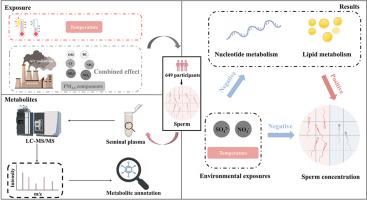PM2.5成分、温度和精液质量之间的关系:来自精浆代谢组学的见解。
IF 7.7
2区 环境科学与生态学
Q1 ENVIRONMENTAL SCIENCES
引用次数: 0
摘要
精液质量下降已成为全球关注的问题,其中环境暴露是关键因素。在这项对中国武汉649名男性的前瞻性队列研究中,我们研究了细颗粒物(PM2.5)成分、环境温度和精液质量之间的关系,并利用非靶向精液代谢组学探讨了潜在的机制。贝叶斯核机回归和广义线性模型显示,高暴露于硝酸盐(NO3-)、硫酸盐(SO42-)和温度与精子浓度降低独立相关。其中,NO3-、SO42-和温度每增加2.72倍,精子浓度分别降低19.41 × 106/mL、47.89 × 106/mL和36.05 × 106/mL。代谢组学分析确定了与每次暴露相关的不同代谢特征:SO42-和温度主要破坏脂质代谢,而NO3-暴露主要破坏核苷酸代谢。值得注意的是,三种代谢物——3-羟基丁基肉碱、二十碳五烯酸和尿苷——始终与所有暴露有关,表明涉及线粒体功能障碍、膜不稳定和氧化应激的共同途径。这些发现提供了分子证据,表明共同发生的环境应激源可以通过趋同的代谢机制损害男性生殖健康,强调了解决个体和组合暴露风险的重要性。本文章由计算机程序翻译,如有差异,请以英文原文为准。

Associations between PM2.5 components, temperature, and semen quality: Insights from seminal plasma metabolome
Declining semen quality has become a global concern, with environmental exposures implicated as key contributors. In this prospective cohort study of 649 men in Wuhan, China, we investigated associations between fine particulate matter (PM2.5) components, ambient temperature, and semen quality, and explored underlying mechanisms using untargeted seminal plasma metabolomics. Bayesian Kernel Machine Regression and generalized linear models revealed that higher exposures to nitrate (NO3−), sulfate (SO42−), and temperature were independently associated with reduced sperm concentration. Specifically, a 2.72-fold increase in NO3−, SO42−, and temperature corresponded to decreases of 19.41 × 106/mL, 47.89 × 106/mL, and 36.05 × 106/mL in sperm concentration, respectively. Metabolomic profiling identified distinct metabolic signatures associated with each exposure: SO42− and temperature predominantly disrupted lipid metabolism, while NO3− exposure primarily disrupted nucleotide metabolism. Notably, three metabolites—3-hydroxybutyrylcarnitine, eicosapentaenoic acid, and uridine—were consistently linked to all exposures, indicating shared pathways involving mitochondrial dysfunction, membrane instability, and oxidative stress. These findings provide molecular evidence that co-occurring environmental stressors can impair male reproductive health via convergent metabolic mechanisms, highlighting the importance of addressing both individual and combined exposure risks.
求助全文
通过发布文献求助,成功后即可免费获取论文全文。
去求助
来源期刊

Environmental Research
环境科学-公共卫生、环境卫生与职业卫生
CiteScore
12.60
自引率
8.40%
发文量
2480
审稿时长
4.7 months
期刊介绍:
The Environmental Research journal presents a broad range of interdisciplinary research, focused on addressing worldwide environmental concerns and featuring innovative findings. Our publication strives to explore relevant anthropogenic issues across various environmental sectors, showcasing practical applications in real-life settings.
 求助内容:
求助内容: 应助结果提醒方式:
应助结果提醒方式:


